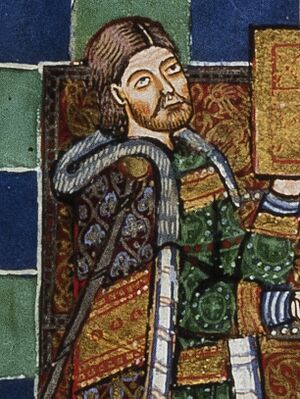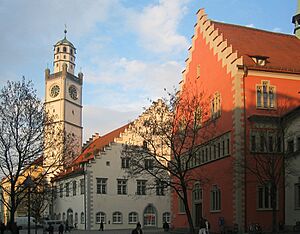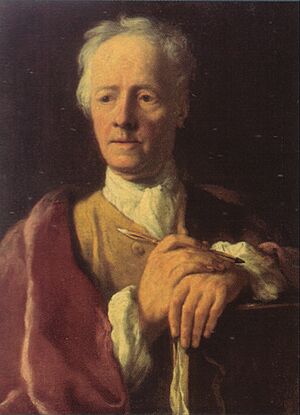Ravensburg facts for kids
Quick facts for kids
Ravensburg
|
|||
|---|---|---|---|

Ravensburg, seen from the west
|
|||
|
|||
| Country | Germany | ||
| State | Baden-Württemberg | ||
| District | Ravensburg | ||
| Municipal assoc. | Mittleres Schussental | ||
| Elevation | 450 m (1,480 ft) | ||
| Population
(2022-12-31)
|
|||
| • Total | 51,482 | ||
| Time zone | CET/CEST (UTC+1/+2) | ||
| Postal codes |
88212–88214
|
||
| Dialling codes | 0751 | ||
| Vehicle registration | RV | ||
| Website | www.ravensburg.de | ||
Ravensburg is a city in southern Germany, located in a region called Upper Swabia. It is the main city of the Ravensburg district in the state of Baden-Württemberg.
Ravensburg was first mentioned in official records in 1088. During the Middle Ages, it was a very important trading hub. It was known as an Imperial Free City, meaning it was directly controlled by the Holy Roman Emperor, not by a local lord.
A famous company called the "Great Ravensburg Trading Society" had shops and businesses all over Europe. Today, the old city center is still well-preserved. You can see three old city gates and more than 10 towers from its medieval walls.
History of Ravensburg
Ravensburg was first written about in 1088. It was started by the Welfs, a powerful family from Swabia. They made the castle of Ravensburg their main home. Later, this family became Dukes in Bavaria and Saxony.
In 1191, the Hohenstaufen family took over Ravensburg. This happened through an agreement with Welf VI, who was an uncle to the famous Frederick Barbarossa.
After the Hohenstaufen family line ended in 1268, Ravensburg became property of the Holy Roman Empire. In 1276, like many other cities in Swabia, Ravensburg became an Imperial Free City. This meant it had special rights and was quite independent.
The "Great Ravensburg Trading Society" was formed around 1380. It was started by important merchant families from Ravensburg and Konstanz. At first, they mainly traded in linen and a fabric called fustian.
In 1402, one of the first paper mills north of the Alps opened in Ravensburg. This made paper another important product they sold. The trading society also sold exotic spices, wines from the Mediterranean, and ores from Bohemia.
The Great Ravensburg Trading Society closed down in 1530. After this, Ravensburg's economy slowed down. The Thirty Years' War (1618-1648) caused a big drop in the city's population. Swedish soldiers even destroyed the old castle, which is now called "Veitsburg."
After the Protestant Reformation, Ravensburg had a special "paritetic" government. This meant that public jobs were shared equally between Catholics and Protestants. The city council had half Catholic members and half Protestant members. For a while, there were even two mayors at the same time, one Catholic and one Protestant! This system was officially approved after the Thirty Years' War in 1648.
In 1803, Ravensburg lost its status as an Imperial Free City. It first became a small part of Bavaria. Then, in 1810, it joined the Kingdom of Württemberg.
Because Ravensburg was not very rich after the Thirty Years' War, not many new buildings were built. This was actually a good thing! It helped keep the medieval city almost completely intact, with nearly all its old towers and gates still standing.
20th Century Changes
During World War II, Ravensburg was not a target for attacks. It didn't have big weapons factories like some other cities. Instead, it was home to a major aid center for the Swiss Red Cross. Because of this, the historic city center was not damaged by air raids.
After the war in 1945, Ravensburg was in the French occupation zone. In 1952, it became part of the new state of Baden-Württemberg.
In the 1970s, Ravensburg grew bigger. It added smaller towns like Eschach, Schmalegg, and Taldorf. The Ravensburg University of Cooperative Education was also started in the city in 1978.
During the 1980s, the Old Town was carefully restored. All cars passing through the city center were stopped, making it a nicer place for people to walk.
Economy and Transport
Ravensburg is a busy city with many shops in the rich region of Upper Swabia. Not many people are unemployed here. Large cities like Munich, Stuttgart, and Zürich are about a two-hour drive away. Closer cities include Ulm, Konstanz, and Bregenz, which are less than an hour away.
Ravensburg is part of a larger city area that includes Weingarten (Württemberg) and other suburbs. Ravensburg, Weingarten, and Friedrichshafen (by Lake Constance) work together as a major regional center.
Getting Around Ravensburg
Ravensburg is located where several main roads meet: the B30, B31, and B32. A new highway bypass has recently been finished around Ravensburg and Weingarten. The closest airport is in Friedrichshafen, about 15 kilometers south of Ravensburg. The nearest big highways are the A7 and A8 (near Ulm) and the A96 (near Lindau or Wangen im Allgäu).
The railway station in Ravensburg opened in 1847. It was part of the "Swabian Railroad" that went from Stuttgart to Friedrichshafen. This was the oldest railroad in Württemberg. In 1888, a tram line also opened, connecting Ravensburg, Weingarten, and Baienfurt.
Local Businesses
For a long time, making machines has been the main industry here. Many engineering factories started in the late 1800s. Today, the main engineering companies in Ravensburg are part of the Austrian "Andritz Hydro" group.
Ravensburger AG is a very famous company based in the city. They are known worldwide for their board games, jigsaw puzzles, and children's books.
Another well-known company is de:Tekrum, which makes pastries. Since 2005, it has been part of Griesson–de Beukelaer.
Other big companies in Ravensburg include:
- Vetter Pharma: They make pre-filled injection systems for medicines.
- Omira: One of the biggest dairies in southern Germany.
- Hawera Probst: A tool factory that makes hammer drill bits. It's part of Robert Bosch.
- Coveris Rigid: A company that makes packaging.
Media in Ravensburg
The local newspaper is the Schwäbische Zeitung. Radio stations like Radio 7 and Südwestrundfunk also have studios in Ravensburg.
Culture
The most popular festival in Ravensburg is the annual "Rutenfest." It takes place in the middle of the year and is a big celebration for the city.
Sport
The city's football club, FV Ravensburg, was formed in 1893. They have played in a league called the Oberliga Baden-Württemberg several times.
From 2006 to 2010, Ravensburg hosted an international women's ice hockey tournament called the Air Canada Cup or MLP Nations Cup.
Twin towns – sister cities
Ravensburg is connected with these cities around the world:
 Brest, Belarus
Brest, Belarus Coswig, Germany
Coswig, Germany Mollet del Vallès, Spain
Mollet del Vallès, Spain Montélimar, France
Montélimar, France Rivoli, Italy
Rivoli, Italy Aberdare, Wales, United Kingdom
Aberdare, Wales, United Kingdom Varaždin, Croatia
Varaždin, Croatia
Notable People from Ravensburg

Many interesting people have connections to Ravensburg:
- Henry the Lion (1129/1131–1195), a powerful Duke of Saxony and Bavaria.
- Ladislaus Sunthaym (c. 1440 – c. 1512), a historian and geographer.
- Hans Buchner (1483–1538), an organist and composer.
- Joannes Susenbrotus (c. 1484 – c. 1542), a humanist who taught in Ravensburg.
- Franz Joachim Beich (1666–1748), a famous painter.
- Gustav Rümelin (1815–1889), a statistician, teacher, and writer.
- August Natterer (1868–1933), an art brut artist.
- Karl Erb (1877–1958), a tenor singer.
- Elisabeth Gerdts-Rupp (1888–1972), a lawyer, poet, and ethnologist.
- Klaus Schwab (born 1938), an economist who started the World Economic Forum.
- Theo Seiler (born 1949), an eye doctor and physicist, known for eye surgery.
- Andreas Gestrich (born 1952), a historian.
- Gregor Amann (born 1962), a politician.
- Kai Diekmann (born 1964), a journalist.
- Stefanie Dimmeler (born 1967), a biologist and biochemist.
- Kofi Ansuhenne (born 1973), a singer from the group "Bed & Breakfast."
- Linus Roth (born 1977), a classical violinist.
- Wilhelm, Duke of Württemberg (born 1994), head of the House of Württemberg.
Sports Stars
- Siblings Erich Buck (born 1949) & Angelika Buck (born 1950), famous figure skaters.
- Simon Henzler (born 1976), a football player and coach.
- Daniel Unger (born 1978), a triathlete.
- Susanne Fellner (born 1985), an ice hockey player.
- Rahman Soyudogru (born 1989), a footballer, played many games for FV Ravensburg.
- Ömer Toprak (born 1989), a Turkish footballer who played over 300 games.
- Emanuel Buchmann (born 1992), a cyclist from nearby Vogt.
- Anna-Maria Wagner (born 1996), a judoka.
Images for kids
See also
 In Spanish: Ravensburg para niños
In Spanish: Ravensburg para niños






